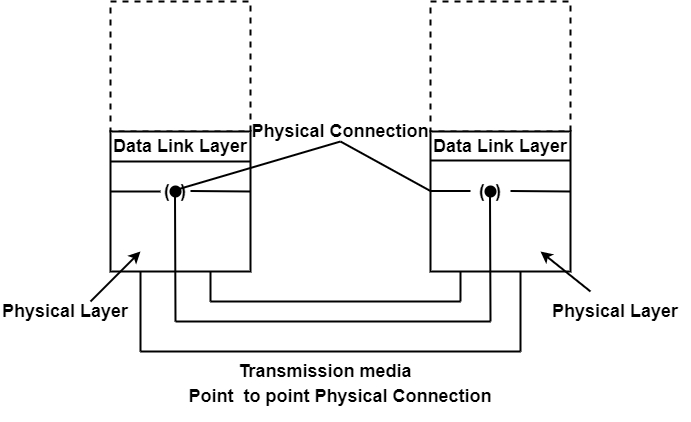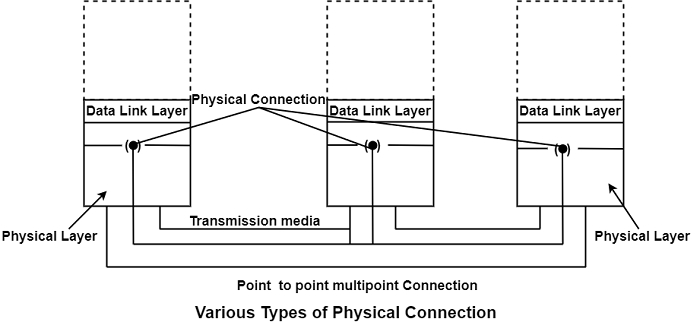
 Data Structure
Data Structure Networking
Networking RDBMS
RDBMS Operating System
Operating System Java
Java MS Excel
MS Excel iOS
iOS HTML
HTML CSS
CSS Android
Android Python
Python C Programming
C Programming C++
C++ C#
C# MongoDB
MongoDB MySQL
MySQL Javascript
Javascript PHP
PHP
- Selected Reading
- UPSC IAS Exams Notes
- Developer's Best Practices
- Questions and Answers
- Effective Resume Writing
- HR Interview Questions
- Computer Glossary
- Who is Who
Explain the functions of a Physical Layer
The physical layer meets all these requirements out. The set of rules and procedures for interaction between physical layers are called Physical layer protocols. The layer provides a physical connection different from the physical transmission path because it is at the bit level while the transmission path is at the electrical signal level.
This physical connection can be a point to point physical connection or point to the multi-point physical connection, as shown in the figure −


The physical layer provides its services to the data link layer, the next higher layer of the OSI model.
The functions of the physical layer are as follows −
Establishing the Physical Connections
Whenever there is a need for data transmission by a computer to another machine, the request travels from the application layer to the data link layer. Then data link layer passes it to the physical layer, and the physical layer activates a physical connection for the transmission of bits.
Activation means if a user initiates a data transmission at one end, then at the other end, the receiver is ready to receive the data message. It is a non-confirmed service. A physical layer after establishing the connection allows a half-duplex or full-duplex transmission of data.
Physical Service Data Unit and Data Transparency
The data link layer hands over the physical service data unit (PSDU) with one bit in the serial transmission and "n" bits in parallel transmission. It can provide transparency of data, i.e., the bit sequences can be transmitted on a transmission channel through it without restricting them.
Sequential Delivery of Data
Though the physical layer does not have any error control mechanism or flow control mechanism, it tries to deliver the data bits in the same sequence in which they were received from the data link layer. Because of the lack of error and flow controls, it can happen that some data bits and duplicated, altered or lost.
Service Primitives
In this layer, it can provide non-confirmed services to the data link layer. The two service primitives attached to it are request primitives and indication primitive. Three phases of these primitives are the activation phase, the deactivation phase, and the data transfer phase. The service primitives, along with services names of the physical layer, are as follows −
Activation Phase
Ph. ACTIVATE. request
Ph. ACTIVATE. indication
Deactivation Phase
Ph. DEACTIVATE. request
Ph. DEACTIVATE. indication
Data Transfer Phase
Ph. DATA. request
Ph. DATA. indication
Fault Detection
The physical layer is also responsible for fault detections in the physical connection. If it detects any fault in the physical connection, it informs the data link layer.
Terminating the Physical Connection
When the data transfer is over, or the user wants a disconnect, the physical layer disconnects the link by deactivating the physical connection at the user’s request. The deactivation service is also non-confirmed.
Signal encoding and Synchronization
The physical layer provides the encoding of signals if required. It also provides the bit synchronization for the transmission of bits in both synchronous and asynchronous transmission. The physical layer does not character synchronization and frame synchronization. They are the responsibility of the data link layer.
Use of Intermediate Relay
A physical connection can use an intermediate relay to overcome the problems like degradation of signal by noise, attenuation, etc., because of the interconnecting medium’s characteristics. For this, signal converting units are used in an intermediate relay where the electrical signals are regenerated, amplified, modulated or equalized of media characteristics according to needs. The physical layer carries out the activation and deactivation of the relay.

